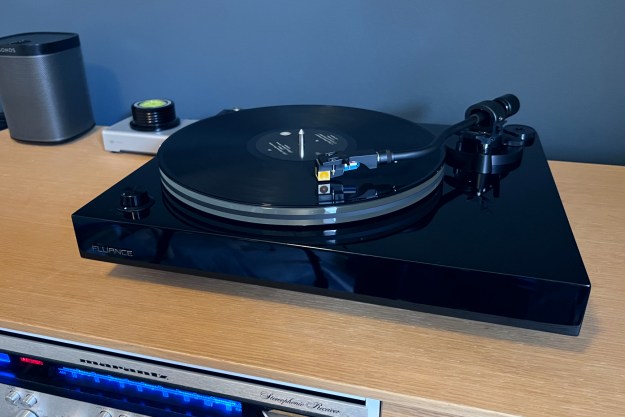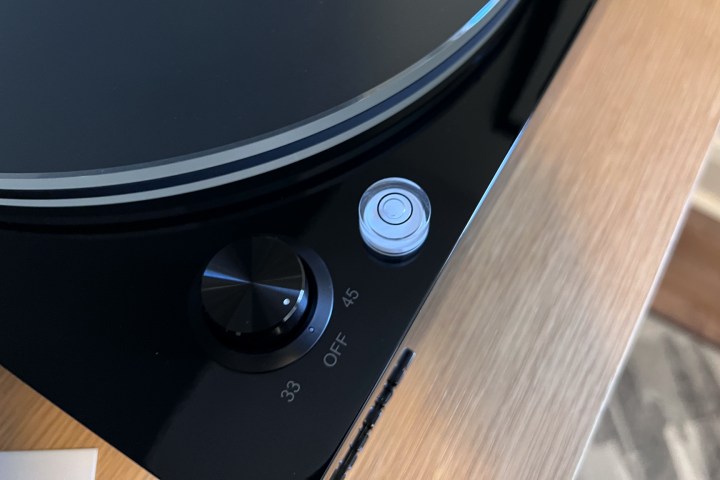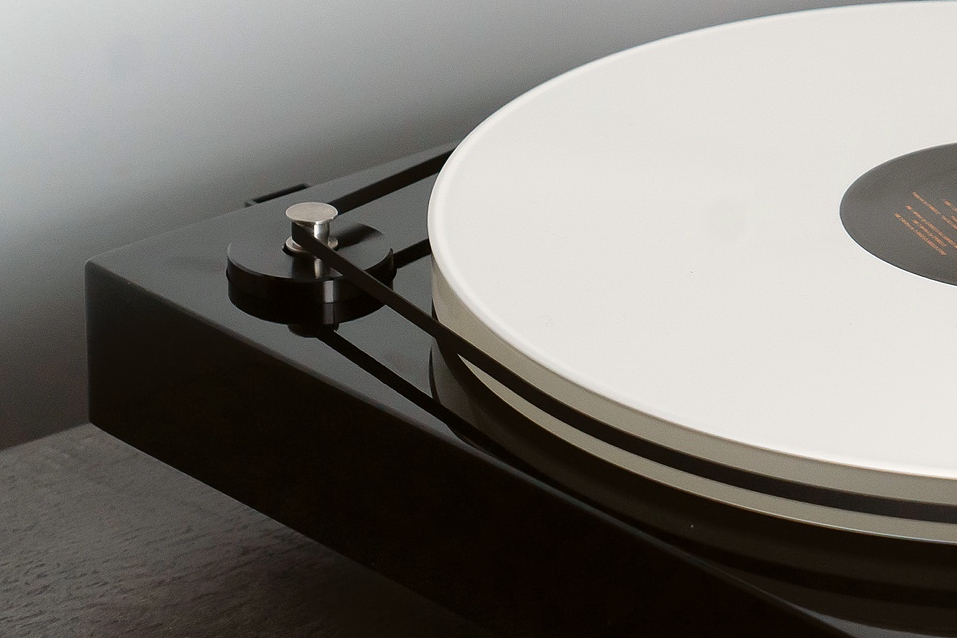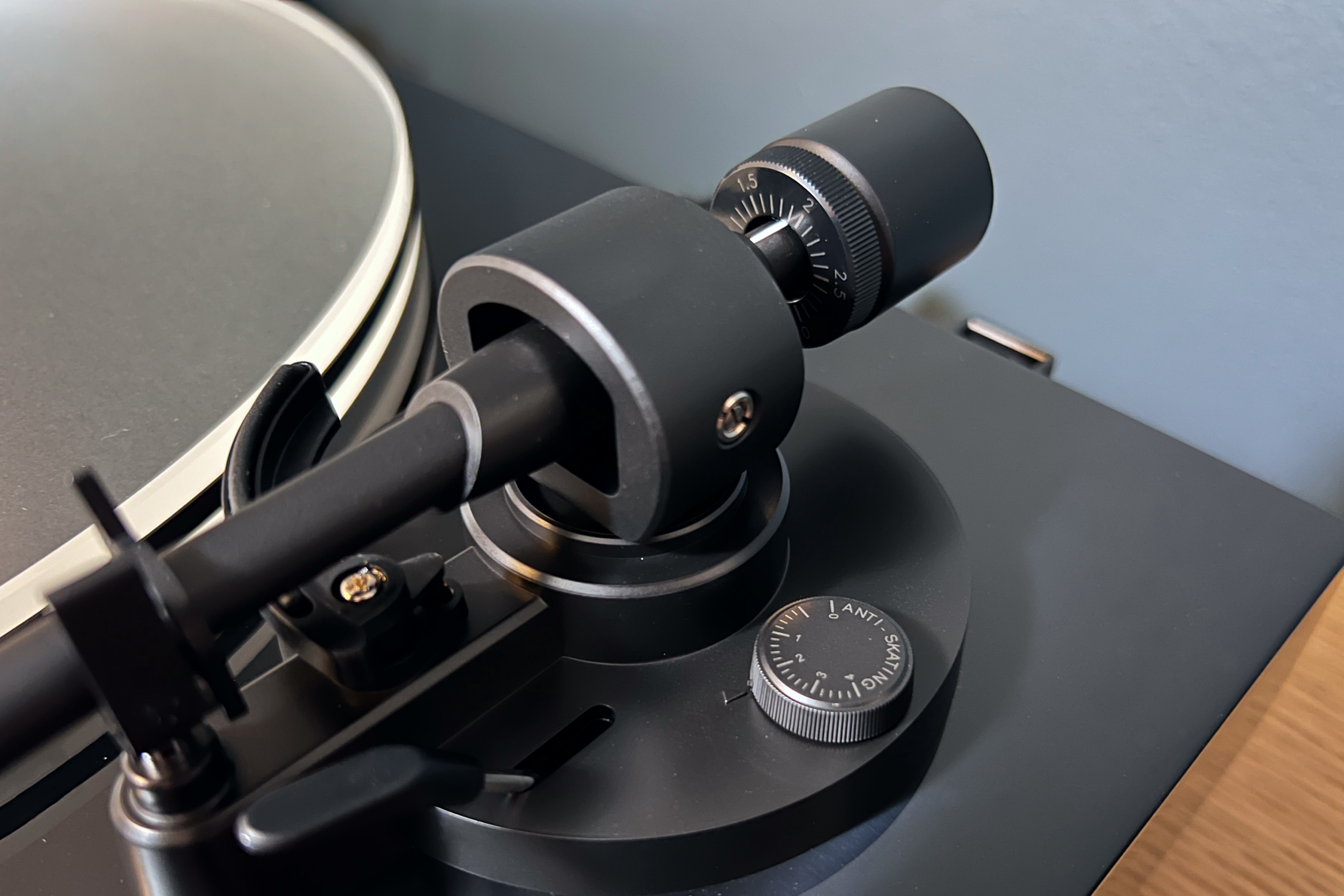
“The Fluance RT85N is a great-sounding, mid-range turntable with features that best some higher-end decks.”
- Full sound that stays true to the source
- Outstanding Nagaoka MP-110 cartridge
- Solid, anti-resonant build quality
- Fuss-free RPM speed control dial
- Automatic stop feature
- No built-in phono preamp
- No Bluetooth or USB connectivity
- Glossy finish prone to fingerprints
Before you go digging out your old CDs in preparation of their foretold second coming, just remember that the original comeback-kid (and reigning champ) in the physical music format resurgence is warm, crackly, vinyl. And specifically, in this case, we’re talking about the Fluance RT85N.
If you’re in the market for a great-sounding, mid-level turntable with a stellar cartridge, and some no-fuss features to get you started, the RT85N ticks all those boxes and more.
Going toe-to-toe with mainstays like Audio Technica’s LP120 ($350), or U-Turn’s popular Orbit series ($499 and up) with its acclaimed Ortofon cartridges, the belt-driven RT85N is stable, quiet, comes with an equally-respectable Nagaoka MP-110 cartridge, and should last for years before you even think about upgrading (and you can, easily), so you can focus on the important part, your soon-to-be-expanding record collection. Let’s dig in.
Note: At the time of this review, the Piano Black model was out of stock on the Fluance website, with availability slated for the end of June 2022. The Natural Walnut is available for pre-order, shipping beginning at the end of April 2022.
Out of the Box
A turntable that doesn’t come fully assembled in its own “suitcase” might look daunting for the uninitiated. But don’t worry, the Fluance RT85N comes with only a handful of components, safely packed and ready to put together — the platter, headshell with the cartridge/stylus already installed, counterweight, RCA cables, rubber belt, power adapter, 45 RPM adapter, dust cover, and the plinth base — neatly in the box. The tonearm is securely fastened in place, and the setup manual and warranty card bag even come with a pair of white cotton gloves and a bubble level for balancing the feet at setup.
Setup

If you’ve never set up a turntable before, it’s all pretty straightforward and can actually be fun. The illustrated instructions with the Fluance RT85N are concise, and easy to follow, with the whole setup taking about 10 to 15 minutes. The booklet takes you through how to install the rubber belt, and connecting the pre-assembled headshell and cartridge to the tonearm literally takes a few turns to tighten.
The first thing you notice when lifting the Fluance RT85N out of the box is its weight. This is no hunk of cheap plastic.
Installing and balancing the tonearm’s counterweight and setting the tracking force (the weight at which the stylus/needle contacts the record) is the crucial part though, as is setting the anti-skate control (the horizontal force that stops the needle from sliding across your records). But just follow the instructions and you’ll be fine. Balancing a tonearm is a good skill to have, as you’ll have to rebalance it from time to time for optimal performance.
Once that’s done, all that’s left is connecting the RCA cables from the turntable to your receiver or phono preamp (the RT85N doesn’t have one built-in) and installing the dust cover.
Design and build

The first thing you notice when lifting the Fluance RT85N out of the box is its 17.7-pound weight. This is no hunk of cheap plastic, and in comparison to other turntables in this body style, such as the 12.5-pound U-Turn Orbit and even the 9.25-pound Rega Planar 1, the RT85N is hefty and sure-footed. Its weight can be attributed to what Fluance calls a “solid wood” plinth, but the specifications section on its own site also lists it as “MDF” (medium-density fiberboard), so we’ve asked Fluance to clarify — we’ll update when we hear back. Either way, it’s heavy and substantial, and comes in either a glossy Natural Walnut veneer or glossy Piano Black outer shell, like our review unit.
On the bottom, you’ll find three rubber isolation feet. But rather than the more common flat, puck-style feet, the Fluance’s are spiked to limit surface contact, thereby reducing vibrations that might be picked up by the cartridge and tonearm.
The 0.62-inch (16mm) thick, high-density clear acrylic platter is also designed to dampen vibrations by “trapping and dissipating the energy,” Fluance says, and for all accounts, it does its job well; the RT85N is one of the quietest, most stable turntables I’ve tested. Additionally, the aluminum S-shaped tonearm is gimbal-balanced and features an anti-skate adjustment and queuing lever so you don’t have to risk scratching your records lifting or lowering the needle if you happen to have shakey hands.
Under the hood, is the RT85N’s servo-regulated, belt-drive. This means that the speed of the turntable’s motor is constantly monitored by a sensor, making adjustments as needed to keep your records spinning at their correct speed, which it does, perfectly. The motor, which is set to the side of the plinth instead of underneath the platter, helps to further reduce resonance and is preferred by audiophiles over direct-drive turntables.
Features and operation

Simple speed selection
Operating the Fluance RT85N is pretty easy. A single, simple dial on the left front of the unit toggles the turntable from the off position to either 33 1/3 or 45 RMP speed settings. Choose your speed and go. Many higher-end turntables, such as the U-Turn Orbit and the legendary Rega Planar 3, as amazing as they sound, all have manually-adjusted speed, meaning you have to physically lift and move the belt to a different spot on the spindle, which can be clumsy and time-consuming if you’re playing a mix of 45s and 33s.
Auto-stop
If you like to putter around the house while spinning records, the RT85N’s auto-stop feature stops the platter at the end of the record, preventing the stylus from running endlessly around the run-out area at the end of the side, which can potentially damage your stylus over time, take some hours off its life. You’d be surprised how many high-end turntables don’t have this feature. It’s the little things.
No phono pre-amp
It should be noted that the Fluance RT85N doesn’t come with a built-in phono preamp, meaning you will need to either connect it to an integrated amplifier or stereo receiver with a phono input or purchase a separate phono stage to connect it to a pair of powered speakers or the AUX input of an amp or receiver. This isn’t necessarily a bad thing, though, as built-in pre-amps tend to be of poor quality, and many end up forking out the extra $100 to $300 for a better-sounding preamp to up their game anyway.
The Fluance RT85N turned out a beautifully clear and full sound that we weren’t expecting from a $499 turntable out of the box.
No Bluetooth or USB
Lastly, if Bluetooth or USB connectivity is at the top of your priority list for a turntable, you’ll have to look elsewhere. Unless you plan on ripping your records to a digital format, then you’re not going to find much use for a USB turntable. Bluetooth, on the other hand, can be a bit handier if you plan on integrating your turntable with your existing networked hi-fi system or want to beam your vinyl to a set of Bluetooth speakers.
Performance

Now to the important part: How does it sound? Running the RT85N through my vintage Marantz 2230 stereo receiver and a pair of modest Wharfedale Diamond 225 bookshelf speakers, it turned out a beautifully clear and full sound that I wasn’t expecting from a $499 turntable out of the box.
Driven largely by the excellent Nagaoka MP-110 Moving Magnet (MM) cartridge, the sound is well-balanced with the lows, mids, and highs all separated comfortably in their own lanes. The bass that the Nagaoka delivers is warm, and not at all boomy, the mids help the vocals sound natural across the board, while the highs stay sharp and clean with a marked reduction in sibilance when compared to cheaper cartridges, such as the Audio Technica AT95E found in many entry-level turntables, including Fluance’s own $250 RT81.
The soundstage was huge (perfect for Zeppelin), with a balanced separation of John Bonham’s drums and John Paul Jones’s bass in the mid-to-back positions.
I put the RT85N through the rigors, playing a wide range of music styles, jumping in first with a legend: Led Zeppelin III. The older, vintage vinyl clicked and popped, delivering that classic vinyl ambiance. The soundstage was huge (perfect for Zeppelin), with a balanced separation of John Bonham’s drums and John Paul Jones’s bass in the mid-to-back positions. The guitars and vocals stood upfront, panned left and right, especially Jimmy Page’s acoustic guitar in Friends, sounding like it was meant to.
Chet Baker’s Chet was up next. Let’s not waste any time and get right to the Miles Davis quote here and say that “It’s not about the notes you play, it’s about the notes you don’t play.” Roll your eyes if you will, but while Baker’s smooth trumpet playing cut through, accompanied by deep, growly baritone sax and pleasantly-round stand-up bass notes, it was the clean and quiet spaces in-between that stood out.
Being a ’90s Grunge kid, I threw on Smashing Pumpkins’ Siamese Dream next to test how the RT85N performed at higher volumes. My small office’s setup is like most people’s — my speakers are on stands without sound-isolating foot spikes, and the turntable sits on a wooden media unit not far from the speakers (they should never be on the same surface as your turntable). At higher volumes, the vibrations always have the potential of resonating through a turntable’s sensitive chassis, platter, tonearm, plinth, and cartridge and can loop back through the speakers creating a lot of noise and feedback. With Siamese Dream‘s thick guitars, piercing drums, and Billy Corgan’s nasally vocals blasting as loud as I was willing to push them, the RT85N’s anti-resonant components managed to contain the volume pretty well, with minimal noise and talkback, even when tapping on the plinth or the table surface. As a comparison, my direct-drive AT-LP120 is much noisier at louder volumes.
Our Take
If you’re on the cusp of jumping into vinyl records but don’t want to mess around with cheap gear you’re only going to have to sell on Facebook Marketplace later, then the Fluance RT85N is a great, reasonably-priced option. Its quiet, anti-resonance build and high-performing Nagaoka MP-110 cartridge alone already give you a leg up on many comparable turntables in the price range and should last you for years. But, as your ear sharpens and your tastes evolve, should you want to upgrade to suit different styles of music, you can, easily.
Is there a better alternative?
If you’re considering the Fluance RT85N, you might want to check out comparable mid-level turntables, such as the U-Turn Orbit Special or the slightly cheaper and more entry-level Audio Technica AT-LP120. While the U-Turn is a popular turntable, you’ll still have to shell out for either an external phono stage or add $70 to the price for a built-in one. However, you’ll have to contend with the aforementioned manual-belt speed change, which is a pain, especially if you plan on playing a lot of 45s. The AT-LP120, on the other hand, is a workhorse of a turntable best suited for DJs for its stability, and while you’ll save $150, its direct drive system isn’t as quiet, and its lower-quality cartridge will have you upgrading almost immediately.
If the cartridge happens to be a sticking point and you know you prefer the sound of Ortofon cartridges, Fluance has a version of the RT85 that’s exactly the same, but it comes with an Ortofon 2M Blue (which retails for around $250 on its own) for the same $499 price. The choice is yours.
How long will it last?
As we mentioned above, the Fluance RT85N comes with a great cartridge, which is the key component when it comes to upgrading a turntable, should you want to go for a higher-end sound. That said, you shouldn’t have to upgrade for a long time, or ever. Combined with the quality of its build and components, this deck should be all you need for years.
Should you buy it?
Yes. The Fluance RT85N may have some competition in the mid-range turntable arena, but the bottom line is that it’s a dynamic, belt-drive turntable that comes with features that other turntables in the price range (and above) don’t have. Plus, it can be easily upgraded, too, giving you complete control of just how crazy you want to get with your new vinyl obsession.









